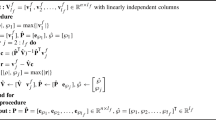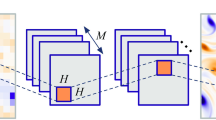Abstract
New variants of the terms involved in the transport equations of Laminar Kinetic Energy (LKE) transition schemes are proposed. The model here proposed was tuned by means of a big experimental data set describing transitional separated flows. Data were acquired by means of time-resolved Particle Image Velocimetry (TR-PIV) measurements above a flat plate centered in a variable area opening channel. Tests were carried out for different free-stream turbulence intensities, Reynolds numbers and adverse pressure gradients. The large amount of test conditions provides the statistical response of the separated flow transition process to the parameter variation. For each condition, Proper Orthogonal Decomposition (POD) was applied to the ensemble of snapshots. Analysis of POD modes and spectra of related temporal coefficients allows us to define a scale separation criterion, and thus construct reduced order models of laminar and turbulent terms appearing in LKE schemes. Combinations of the POD modes of the two velocity components, their gradients and mixed terms involving velocity scales and mean flow strain rates are used to compute the targeting function vectors for the learning of the models. The role played by normal and shear stress-strain mechanisms in the different parts of the separated flow region was addressed for a fine tuning of both the laminar and the turbulent kinetic energy production terms. Additionally, a new definition of the energy transfer rate between the laminar and the turbulent scales is educated, using ingredients representing the work done by the finer scale on the larger one, inspired by the exact definition of the transfer rate appearing in the transport equations of coherent and incoherent fluctuations. An elastic-net technique was used to identify the best predictors, thus the model learning. The ability of the proposed model is verified by using it to predict results obtained in a different experimental database that did not participate to the education of the model.












Similar content being viewed by others
References
Borée, J.: Extended proper orthogonal decomposition: a tool to analyse correlated events in turbulent flows. Exp. Fluids 35(2), 188–192 (2003)
Brunton, S.L., Proctor, J.L., Kutz, J.N.: Discovering governing equations from data by sparse identification of nonlinear dynamical systems. Proc. Natl. Acad. Sci. 113(15), 3932–3937 (2016)
Canepa, E., Cattanei, A., Zecchin, F.M., Parodi, D.: Large-scale unsteady flow structures in the leakage flow of a low-speed axial fan with rotating shroud. Exp. Thermal Fluid Sci. 102, 1–19 (2019)
Dick, E., Kubacki, S.: Transition models for turbomachinery boundary layer flows: a review. Int. J. Turbomach. Propuls. Power 2(2), 4 (2017)
Fu, W.J.: Penalized regressions: the bridge versus the lasso. J. Comput. Graph. Stat. 7(3), 397–416 (1998)
Gatski, T., Speziale, C.: On explicit algebraic stress models for complex turbulent flows. J. Fluid Mech. 254, 59–78 (1993)
Hadžić, I., Hanjalić, K.: Separation-induced transition to turbulence: second-moment closure modelling. Flow Turbul. Combust. 63(1–4), 153 (2000)
Hanjalić, K., Launder, B., Schiestel, R.: Multiple-time-scale concepts in turbulent transport modeling. Turbul. Shear Flows 2, 36–49 (1980)
Hoerl, A., Kennard, R.: Ridge regression. Encycl. Stat. Sci. 8, 129–136 (1996)
Howard, R., Alam, M., Sandham, N.: Two-equation turbulence modelling of a transitional separation bubble. Flow Turbul. Combust. 63(1–4), 175–191 (2000)
Jovanović, M., Schmid, P., Nichols, J.: Sparsity-promoting dynamic mode decomposition. Phys. Fluids 26, 024103 (2014)
Kutz, J.N., Brunton, S.L., Brunton, B.W., Proctor, J.L.: Dynamic mode decomposition: data-driven modeling of complex systems. SIAM (2016)
Lardeau, S., Leschziner, M., Li, N.: Modelling bypass transition with low-Reynolds-number nonlinear eddy-viscosity closure. Flow Turbul. Combust. 73(1), 49–76 (2004)
Lengani, D., Simoni, D., Pichler, R., Sandberg, R., Michelassi, V., Bertini, F.: Identification and quantification of losses in a LPT cascade by POD applied to LES data. Int. J. Heat Fluid Flows 70, 28–40 (2018)
Lengani, D., Simoni, D., Ubaldi, M., Zunino, P.: POD analysis of the unsteady behavior of a laminar separation bubble. Exp. Therm. Fluid Sci 58, 70–79 (2014)
Lengani, D., Simoni, D., Ubaldi, M., Zunino, P., Bertini, F.: Analysis of the Reynolds stress component production in a laminar separation bubble. Int. J. Heat Fluid Flow 64, 112–119 (2017a)
Lengani, D., Simoni, D., Ubaldi, M., Zunino, P., Bertini, F.: Experimental investigation on the time-space evolution of a laminar separation bubble by proper orthogonal decomposition and dynamic mode decomposition. J. Turbomach. 139(3), 031006 (2017b)
Lengani, D., Simoni, D., Ubaldi, M., Zunino, P., Bertini, F., Michelassi, V.: Accurate estimation of profile losses and analysis of loss generation mechanisms in a turbine cascade. J. Turbomach. 139(12), 121007 (2017c)
Leschziner, M.: Statistical Turbulence Modelling for Fluid Dynamics-Demystified: an Introductory Text for Graduate Engineering Students. World Scientific (2015)
Ling, J., Kurzawski, A., Templeton, J.: Reynolds averaged turbulence modelling using deep neural networks with embedded invariance. J. Fluid Mech. 807, 155–166 (2016)
Marconcini, M., Rubechini, F., Pacciani, R., Arnone, A., Bertini, F.: Redesign of high-lift low pressure turbine airfoils for low speed testing. ASME J. Turbomach. 134(5), 051017 (2012)
Marxen, O., Rist, U.: Mean flow deformation in a laminar separation bubble: separation and stability characteristics. J. Fluid Mech. 660, 37–54 (2010)
Marxen, O., Zaki, T.A.: Turbulence in intermittent transitional boundary layers and in turbulence spots. J. Fluid Mech. 860, 350–383 (2019)
Mayle, R., Schulz, A.: The path to predicting bypass transition. J. Turbomach. 119(3), 405–411 (1997)
Pacciani, R., Marconcini, M., Arnone, A., Bertini, F.: A CFD study of low reynolds number flow in high lift cascades. Proceedings of the ASME Turbo Expo 2010: Power for Land, Sea, and Air 7, Turbomachinery, Parts A, B, and C. 1525–1534 (2010)
Pacciani, R., Marconcini, M., Fadai-Ghotbi, A., Lardeau, S., Leschziner, M.A.: Calculation of high-lift cascades in low pressure turbine conditions using a three-equation model. J. Turbomach. 133(3), 031016 (2011)
Pope, S.: Turbulent Flows. Cambridge University Press, Cambridge (2000)
Reynolds, W., Hussain, A.: The mechanics of an organized wave in turbulent shear flow. Part 3. Theoretical models and comparisons with experiments. J. Fluid Mech. 54(2), 263–288 (1972)
Sandberg, R., Tan, R., Weatheritt, J., Ooi, A., Haghiri, A., Michelassi, V., Laskowski, G.: Applying machine learnt explicit algebraic stress and scalar flux models to a fundamental trailing edge slot. J. Turbomach. 140(10), 101008 (2018)
Schmelzer, M., Dwight, R., Cinnella, P.: Discovery of algebraic reynolds-stress models using sparse symbolic regression. Flow Turbul. Combust. 104, 579–603 (2020)
Simoni, D., Lengani, D., Dellacasagrande, M., Kubacki, S., Dick, E.: An accurate data base on laminar-to-turbulent transition in variaible pressure gradient flows. Int. J. Heat Fluid Flow 77, 84–97 (2019)
Simoni, D., Lengani, D., Ubaldi, M., Zunino, P., Dellacasagrande, M.: Inspection of the dynamic properties of laminar separation bubbles: free-stream turbulence intensity effects for different Reynolds numbers. Exp. Fluids 58(6), 66 (2017)
Simoni, D., Ubaldi, M., Zunino, P., Lengani, D., Bertini, F.: An experimental investigation of the separated-flow transition under high-lift turbine blade pressure gradients. Flow Turbul. Combust. 88(1–2), 45–62 (2012)
Sirovich, L.: Turbulence and the dynamics of coherent structures. Part I–III. Q. Appl. Math. 45, 561–590 (1987)
Tibshirani, R.: Regression shrinkage and selection via the Lasso. J. R. Stat. Soc. B 58(1), 267–288 (1996)
Walters, D.K., Leylek, J.H.: A new model for boundary layer transition using a single-point RANS approach. J. Turbomach. 126(1), 193–202 (2004)
Zou, H., Hastie, T.: Regularization and variable selection via the elastic net. J. R. Stat. Soc. B 67, 301–320 (2005)
Author information
Authors and Affiliations
Corresponding author
Ethics declarations
Conflict of interest
The authors declare that they have no conflict of interest.
Appendix
Appendix
Rights and permissions
About this article
Cite this article
Daniele, S., Dario, B., Matteo, D. et al. Modified Formulation of Laminar Kinetic Energy Transition Models by Means of Elastic-Net of a Big Experimental Database of Separated Flows. Flow Turbulence Combust 105, 671–697 (2020). https://doi.org/10.1007/s10494-020-00124-2
Received:
Accepted:
Published:
Issue Date:
DOI: https://doi.org/10.1007/s10494-020-00124-2




